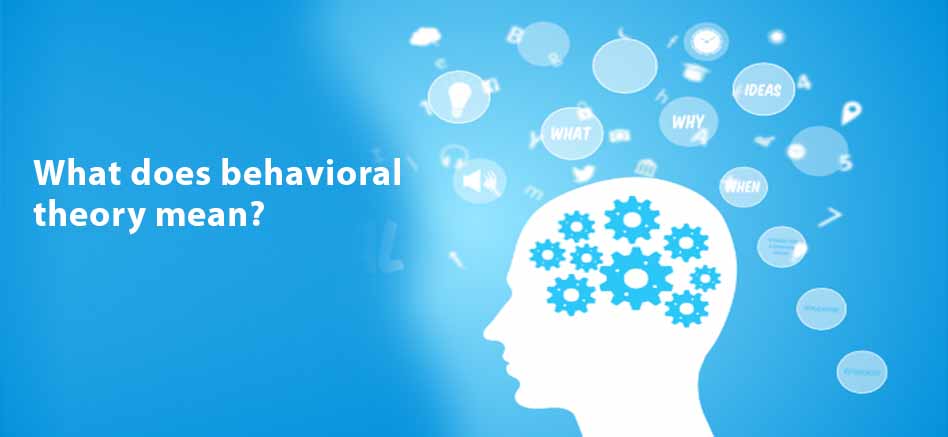
What does behavioral theory mean?
The goal in behavioral therapy is to strengthen honest behavior and eliminate unwanted or unfavorable ones. Behavioral play is based on the principles of principle, a thought painting based on the idea we learn from our environment. The techniques used for this type of treatment are based on theories of conventional equations and operation equations.
It is important to consider the different behavioral patterns that, unlike psychotherapy and other forms of psychotherapy, implement behavioral play. Behavioral therapists focus on using the same learning strategies that led to difficult behaviors.
Because of this, behavioral therapy can be highly elevated. Behavior is the problem. The goal is to minimize or eliminate problems for new clients. Led to the development of an old learning problem. So new learning can fix that.
There are also three main areas on the principles of behavioral therapy:
Therapeutic-behavioral functional therapy depends on behavioral methods. Focuses on the problematic thoughts behind the behavior.
Applied Behavior Analysis uses the Operation Equation to shape and modify problem behaviors.
Social learning theory focuses on how people learn through observation. Observing satisfaction or punishment for the good of others can change learning and behavior.
Short background
The first can be called Edward Trondadic’s idea of changing behavior. Pioneers of other behavioral patterns were the psychologists Joseph Woley and Hans Eisenhower.
Behavioralists have been instrumental in the development of BF Skinner’s work on behavioral therapy, and he has introduced a number of concepts and techniques that are still in use today.
Later, psychologists such as Aaron Beck and Albert Elias added a cognitive element to behavioral strategies to develop a treatment called cognitive behavioral therapy (CBT).
The basis of routine exercise
To understand how behavioral therapy works, we begin by studying the two basic principles that contribute to behavioral play. Classic and functional conditioning.
Classic air conditioners can make connections between stimuli. Previously neutral stimuli have been associated with a stimulus that responds naturally and automatically. After re-pairing, an association is formed, and the previously inactivated stimulus will come to trigger its own response.
Strengthening to increase or decrease the frequency of behaviors and setting operating conditions on how penalties can be applied. It is likely to happen again in the future, following in the footsteps of the positive consequences that followed.
Classical therapy is based on conventional complication
Traditional behavior is one way to change behavior, and such changes can be made.
Originally referred to as behavior change, such therapies are often referred to as applied behavior analysis.
The following are some of the methods and strategies used for this approach:
Flooding: This process is to intimidate people into embracing materials or opportunities intensely and rapidly. It is often used to treat phobias, anxiety and other stress related disorders. In the process, the person is prevented from getting out of the situation or avoiding it.
For example, flooding can be used to help a client who is suffering from a severe fear of dogs. Initially, the client may be exposed to a small friendly dog during the period of his or her absence.
When nothing bad happens after repeated exposure to the dog, the fear begins to respond.
Systematic Acceleration: This method teaches the client to make a list of threats and then relax the person by focusing on these fears. The use of this procedure was started by psychiatrist John B. By experimenting with Watson and his Pearl Atabet. He decided a small child to be afraid of white mice. Mary Cover later reproduced Jones Watson’s results and used reconstruction techniques to cancel and revise the fear response.
Systematic desensitization is often used to treat phobias. The process follows three basic steps.
First, the client uses flexible technology.
Next, the person creates a ranking list of instances of panic.
Starting with the least frightening items and working up to the most frightening noble matter, the client faces these fears under the guidance of the Vice-Chancellor while maintaining a relaxed state.
For example, a person who is afraid of the dark may start by looking at an image of a dark room before facing his mind because he is sitting in a dark room before he thinks about being in a dark room. The phobic reaction can be reduced or eliminated by pairing the stimuli produced by the old fear with the newly learned relaxed behavior.
Antiviral therapy: This process is associated with a pessimistic stimulus that is expected to reduce the risk of unwanted behavior. For example, a person suffering from alcoholism is called disulfiram